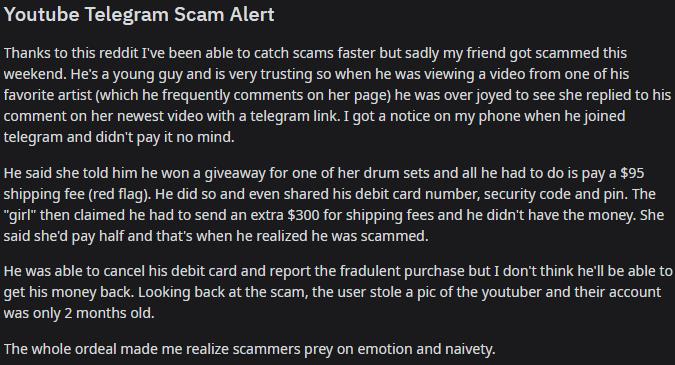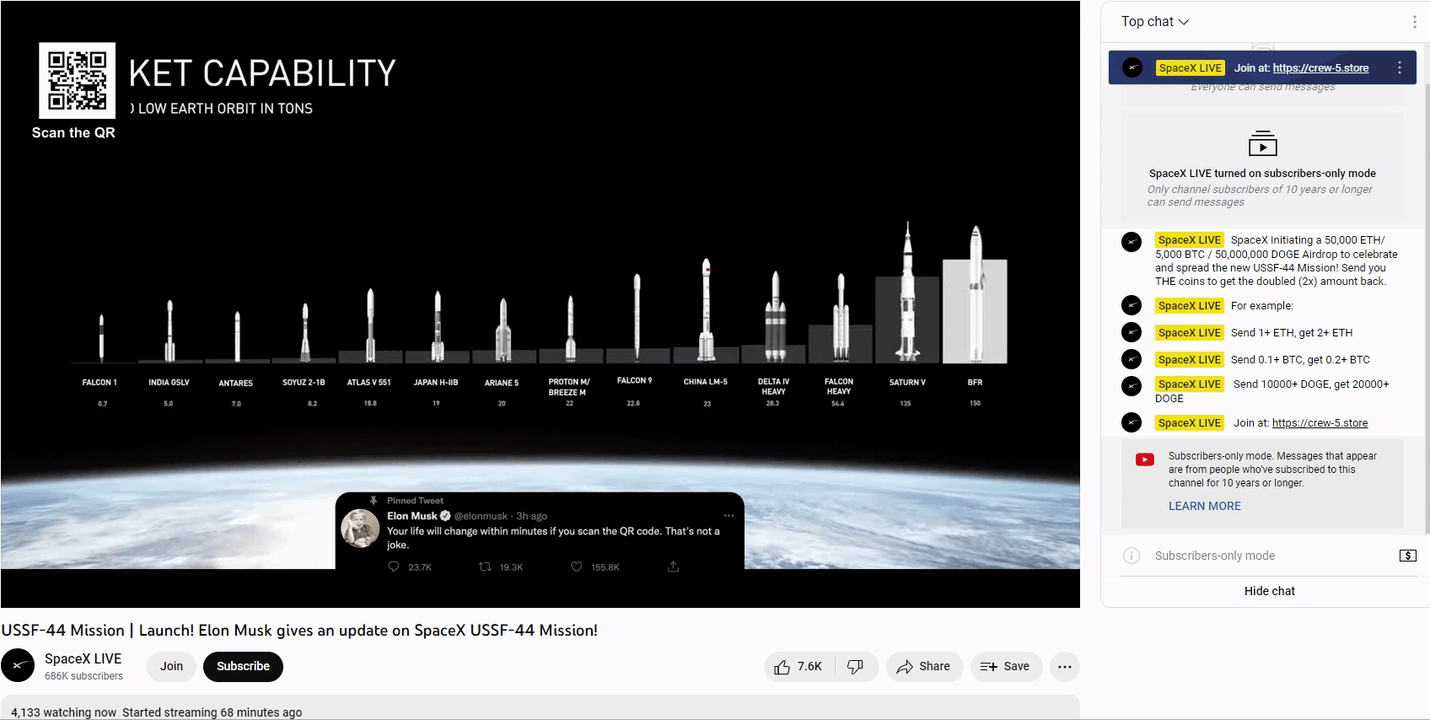The YouTube-Telegram Giveaway Scam
When I began researching the YouTube giveaway scams, I expected to find a cold trail. It's been over a year since ThioJoe, a tech news and education channel with nearly 3 million subscribers, posted his first video on his experience trying to remove hundreds of impersonators from his videos. Five months later, after Marques Brownlee made a video on the topic, YouTube began taking tentative steps to address the issue. But a quick Reddit search reveals that YouTube impersonators and giveaway scams are still alive and well today.
How does the scam work?
The scammer sets up a YouTube profile copying the real creator’s profile picture and name. Sometimes the method used to impersonate the channel name is quite clever, such as using foreign characters to create a look-alike, or simply misspelling the name in such a way that our brain is likely to auto-correct it.
Other times, the channel name should be an instant giveaway (no pun intended).
Once on Telegram, the “winner” is often asked to pay for shipping. In the example below it is a ridiculous amount - $95 - that keeps going up as long as the victim keeps sending money. As soon as the scammer has fleeced one victim or one YouTuber’s channel for everything they can get, they simply change their profile picture and channel name and move on.
Who falls for this?
Unfortunately, naïve people whose emotions get the better of them and who are elated to have won something from a creator they look up to. If they were to click on the commenter’s name they would discover that it is not the same channel - not even close.
These impersonations aren’t even that well done or hard to spot, which is even more frustrating to the creators who wonder why YouTube isn't doing something.
Table of Contents
If there’s a problem, there’s a fix. Right?
If someone has established an identity on YouTube across tens, hundreds, or even thousands of videos, has shown their face, and maybe even has that Verified checkmark next to their channel name, then someone using their exact profile picture and commenting in their videos claiming to be them should be an easy target for YouTube’s algorithm to expunge. Right?
What if they also wrote hundreds of comments on a single video claiming to give away free stuff in a manner that directly violates YouTube’s Contest Policies? Wouldn’t it be an easy ban for YouTube to enforce?
And once the channel was banned for scamming, wouldn’t their hundreds of scam comments be automatically deleted from the platform?
If you answered NO to all of the above then your perception of YouTube’s current capability of handling these scams is sadly accurate.
ThioJoe thoroughly documented his experience reporting the scammers to YouTube. YouTube refused to ban several scam channels impersonating him, claiming that “for the rest of the channel[s] that you reported we have confirmed that it didn’t violate our community guidelines.” ThioJoe checked the channel that YouTube refused to ban, and found it had moved on to spamming other accounts with its WhatsApp scam. So he followed up, linking to the videos where they were active and sending screenshots. YouTube responded: “our team actually checked these channels against our guidelines on impersonation and they confirmed that those channels didn’t violate our Community Guidelines.” Right.
And even for those channels that were banned, their hundreds of scam comments - the crux of the issue - were not removed. That was up to the YouTuber to do manually, comment by comment, video by video. ThioJoe discovered some impersonator accounts that had left over 200 comments on a single one of his videos.
Realizing that YouTube was not going to help him, he made his own app to bulk-delete spam comments - free for anyone to use.
So yes, there’s a fix. Just not by YouTube.
YouTube responds…kind of
In April 2022, five months after ThioJoe posted his original video detailing the scams, and shortly after Marques Brownlee - a much larger YouTuber - posted his, YouTube began testing a stricter content moderation tool for creators. On June 30th they released an update disabling the option to hide your subscriber count and limiting the type and/or frequency of special characters in channel names.
It’s a start, but it’s not enough. While researching this article I learned that fake SpaceX channels have been popping up on YouTube and running cryptocurrency scams. One got shut down about a month ago.
So I searched for SpaceX on YouTube, and lo and behold, SpaceX LIVE was livestreaming!
Over 600,000 “subscribers” (read: bots). 4,000 “people” watching. And a subscriber’s-only live chat claiming that if you send them one BTC (or Ethereum or Monero - they’re not picky) you’ll get two back. What a deal!
I left this stream running in the background while I worked.
A week later it was taken down.
New YouTube Scams
Since 2022, YouTube scams have not only persisted but evolved, becoming more sophisticated and harder to detect. Modern scammers are using advanced tactics, combining platforms like Telegram, WhatsApp, and even fake websites to further exploit unsuspecting viewers. Here are some of the latest scams circulating on YouTube in 2024:
Fake Collaborations & Sponsorship Scams
Scammers now impersonate YouTube creators or brands to offer fake sponsorships or collaborations. Creators, especially smaller ones, are approached by "brand representatives" via email or social media with a lucrative offer. These scams often ask for an upfront fee or for the creator to install malicious software in the guise of a sponsorship package, compromising their device or stealing sensitive data.
AI Deepfakes & Livestream Scams
The rise of AI technology has given scammers new tools to imitate popular creators. Scammers are now using AI-generated deepfake videos to impersonate real YouTubers in livestreams. They fake giveaways, promising high-value items like Bitcoin or luxury electronics, asking viewers to "send payment first." The AI-generated videos make it harder for viewers to identify the scam until it's too late.
Telegram Giveaway Scams
While the use of Telegram for scams has been around for a few years, scammers have stepped up their game. In 2024, Telegram groups are increasingly being used to run fake lotteries and giveaways. Scammers often promise exclusive prizes for joining their Telegram channel and following specific instructions. They may even mimic legitimate YouTube channels' branding, convincing users to send money for "processing fees" or "shipping costs." These fees never stop, and victims can be milked for hundreds, if not thousands, before realizing they’ve been scammed.
QR Code Scams
A newer tactic involves scammers posting QR codes in YouTube comments, claiming it will lead users to claim their prize or offer. These QR codes lead to phishing websites designed to steal login credentials or even install malware on the victim's device. The scammers then use this data to gain access to bank accounts, social media profiles, and other sensitive information.
Fake Membership & Subscription Alerts
With the rise of YouTube’s paid membership features, scammers now target users by mimicking membership alerts. They pose as official YouTube or channel-related notifications, tricking users into thinking their membership or subscription has expired. They then redirect the user to a fake payment page to "renew" their membership, stealing their credit card details in the process.
These scams are becoming more professional in appearance, making it harder for users to differentiate between legitimate offers and scams. As always, vigilance is key. Double-check any messages claiming you’ve won something, especially if you're asked to provide personal information or payments.
What can we do?
With YouTube forcing subscriber counts to show, it should be quite obvious when a commenter’s account is an impersonation of the creator whose video you’re watching. However, in cases such as the fake SpaceX LIVE livestream, the channel probably used bots to get a legitimate-looking subscriber count.
YouTube’s contest policy explicitly states that you must have official rules for the contest. If the creator hasn’t mentioned that they’re doing a giveaway…then they’re not.
In general, use common sense. If they’re asking you to give something to get something, don’t. You can always post a screenshot to /r/Scams to get another opinion.
In the meantime, creators will continue to suffer as the mysteries of YouTube’s algorithms rampage across the platform, striking original, legitimate videos and sparing scammers their comeuppance.



